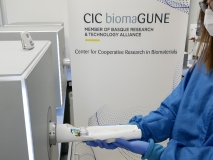CIC biomaGUNE has participated in the identification of new mechanisms associated with neurodegeneration in rare Batten disease; they have just been published in Nature Communications. This research, led by the University of Salamanca, has been studying the molecular mechanisms and identifying the possible therapeutic targets with which to try to alleviate the symptoms of a childhood disease known as neuronal ceroid lipofuscinosis.
More than 1,000 patients across Europe suffer from this disease, which causes debilitating genetic disorders, especially in children who go on to suffer from progressive dementia and motor impairment as a result. "In this rare inherited disease an abnormal material called lipofuscin builds up in the brain. It is thought to be caused by problems in the brain's ability to eliminate and recycle proteins," explained CIC biomaGUNE Ikerbasque Professor Pedro Ramos-Cabrer.
Through imaging techniques, CIC biomaGUNE assisted in testing in in vivo models the working hypotheses raised by researchers at the University of Salamanca in studies involving in vitro cells. CIC biomaGUNE is one of the most advanced centers in molecular imaging in Europe (it is the main node of the Singular Scientific and Technical Infrastructure-ICTS, RedIB); it made available its facilities and the experience and capabilities of its researchers in the design and conducting of in vivo studies in animal models of diseases of the central nervous system. In this respect, CIC biomaGUNE researcher Jordi Llop designed and conducted PET imaging studies in an animal model of Batten disease, and Ikerbasque Professor Pedro Ramos designed and conducted Magnetic Resonance studies (imaging and spectroscopy) in the same animals, thus proving the working hypothesis in in vivo models.
Dysfunctional mitochondria and glycolysis
This work made it possible to identify how "the build-up of dysfunctional mitochondria takes place and to observe an aberrant increase in the glycolytic protein PFKFB3" in the neurons of a genetic mouse model for this disease, reported Prof Bolaños, a University of Salamanca professor and leader of the research. This is a factor that has consequences for the normal metabolism of these cells and causes serious metabolic alterations responsible for neuronal degeneration. The researchers also observed that pharmacological inhibition of the activity of this protein in this mouse model is able to rescue a good portion of the typical markers of the disease, which opens up the way to embarking on a new line of research.
A characteristic feature of this disease is the loss of autophagy, a process that takes place inside cells to eliminate damaged macromolecules and organelles. Based on this premise, the scientists studied the possible effect of autophagic damage to the cellular machinery in charge of brain energy metabolism in Batten disease.
So they managed to resolve the fact that mitochondria –responsible for obtaining most of the energy necessary for physiological functions– build up in large quantities in the neurons of the model mice, are disproportionately large and are dysfunctional, which deprives them of their main source of energy. This fact alone could explain "the neuronal degeneration in this disease," they pointed out. The researchers also observed that as a result of mitochondrial dysfunction, the neurons reactivate an alternative pathway for obtaining energy: glycolysis.
So the study shows how glycolysis enables cells to normally obtain nearly all the energy they need, and identifies the molecular mechanism that links mitochondrial dysfunction to increased glycolysis. In this regard, the professor stressed that "the increase in glycolysis that takes place reprograms the rest of the intracellular metabolism from other essential metabolic pathways", which has consequences for the normal metabolism of these cells and "causes serious metabolic alterations responsible for neuronal degeneration".
In its subsequent phase, the work focused on the pharmacological approach, and the result of the treatment applied showed that most of the biomarkers of the disease were reversed in the mouse model. At present, the strategy awaits implementation in a clinical trial, for which its efficacy must first be tested in at least two more models of the disease.

